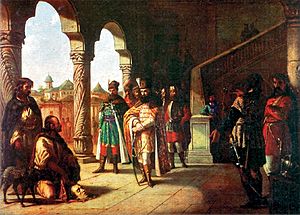Battle of Șelimbăr facts for kids
Quick facts for kids Battle of Șelimbar |
|||||||
|---|---|---|---|---|---|---|---|
| Part of the Long Turkish War | |||||||
 Székelys bring the head of Cardinal Andrew Báthory to Michael the Brave (Theodor Aman) |
|||||||
|
|||||||
| Belligerents | |||||||
|
Székelys Serb hajduks Cossack and Hungarian mercenaries |
Principality of Transylvania Cossack mercenaries |
||||||
| Commanders and leaders | |||||||
| Michael the Brave Starina Novak |
Andrew Báthory Gaspar Kornis (POW) |
||||||
| Strength | |||||||
| 20,000 - 30,000 men 18 cannons |
15,000 - 25,000 men | ||||||
| Casualties and losses | |||||||
| 200 - 1,000 | 1,200 - 1,500 | ||||||
The Battle of Șelimbăr (also called the Battle of Sellenberk) was a major fight that happened on October 18, 1599. It was fought near the village of Șelimbăr in Transylvania, which is now part of Romania. The battle was between the army of Michael the Brave, who was the ruler (or voivode) of Wallachia, and the army of Andrew Báthory, the ruler of Transylvania. Michael the Brave won this important battle.
Contents
Why the Battle Happened: The Background
Michael the Brave's Goals
In the late 1500s, Michael the Brave, the ruler of Wallachia, wanted to fight against the powerful Ottoman Empire. He also wanted to make sure his own land was safe.
Alliances and Tensions
At this time, the rulers of nearby Transylvania and Moldavia were friendly with Poland. Poland, in turn, had good relations with the Ottomans. This made Michael feel like he was surrounded by potential enemies. He needed strong allies.
Michael found an ally in the Habsburgs, who ruled a large empire in Europe. In 1598, Michael signed a deal with Emperor Rudolph, the Habsburg ruler. This agreement meant Wallachia would become a "vassal state," which meant it would be under the emperor's protection. In return, the emperor agreed to pay for 5,000 soldiers to help Wallachia.
Marching into Transylvania
Michael wanted to connect his lands with his new ally, Emperor Rudolph. With the emperor's approval, he decided to move his army into Transylvania. He told the Székelys, a group of people living in Transylvania, that he was acting on behalf of the emperor. He promised to give them back their old freedoms if they joined his side. Many Székelys joined Michael's army, making up about one-third of his 36,000 soldiers.
Michael's main army entered Transylvania through the Buzău Pass. Another part of his army, about 6,000 fighters from Oltenia, came through the Turnu Roşu Pass. These two groups met up on October 16, ready for battle.
The Battle: A Clash of Armies
Army Strengths
Michael the Brave had around 40,000 soldiers ready for the fight. However, not all of them fought. Some stayed behind to guard the families of the noblemen (called boyars) who had joined the campaign. They were worried about possible attacks from the Tatars back in Wallachia.
Andrew Báthory's army had about 30,000 men. But during the battle, many of his soldiers switched sides and joined Michael's army. This was especially true for the Székelys, who did not like the Báthory family that ruled Transylvania.
Key Moments of the Fight
At the start of the battle, Michael's Wallachian forces seemed to be winning. But then, the Hungarian Hussars (a type of cavalry) charged and pushed them back. It looked like the Transylvanians might win.
However, Andrew Báthory made a mistake. He did not send his reserve troops (soldiers kept ready for a critical moment) into the fight. This gave Michael's army a chance to regroup and prepare for another attack.
Michael's forces then launched a strong counter-attack against the Transylvanian army. This time, their charge was successful. Andrew Báthory had to flee the battlefield. Sadly, he was later killed.
After the Victory
After his victory, Michael the Brave and his army marched to the city of Alba Iulia. The local assembly (called the Diet) recognized him as the new ruler of Transylvania and the emperor's governor.
The battle was costly for both sides. The Transylvanians lost between 1,200 and 1,500 men. Michael's Wallachian army lost fewer soldiers, between 200 and 1,000. The people of Sibiu buried the dead in a large grave, which is now known as Michael the Brave's Knoll.
What Happened Next: The Aftermath
Michael's Rule in Transylvania
Michael's victory meant he took control of Transylvania. He managed the region on behalf of Emperor Rudolph. It's important to know that Michael did not try to make Transylvania part of Wallachia. He also didn't change Transylvania's way of government. In fact, he even invited some Székelys and other Transylvanian Hungarians to help him run Wallachia. He wanted to bring some of Transylvania's more advanced systems to Wallachia.
A National Hero
Over time, especially during the period when Romanians were developing their national identity, Michael's victories were seen as the first step towards uniting the Romanian people. Because of this, Michael the Brave is still considered a great national hero in Romania today.
See also
- Battle of Sellenberk (1916)

